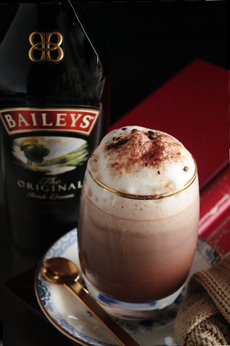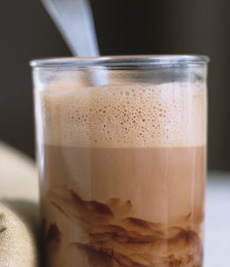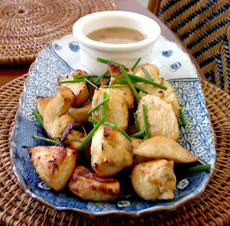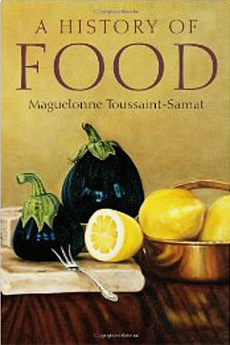|
It’s National Chocolate Milk Day.
We spent two days last week at a trade show that focused on natural and healthy products. Among the many aloe and coconut water brands, we tried alternative types of chocolate milk: almond milk (Almond Breeze), soy milk (Silk), rice milk (Rice Dream), hemp milk (Living Harvest), coconut milk (So Delicious) and even oat milk (Pure Harvest).
The oat milk tasted a bit oaty, but few people would have guessed if handed a glass, that Almond Breeze chocolate almond milk and Silk chocolate soy milk were not cow’s milk (Almond Breeze is also available as unsweetened chocolate milk, an option for those who wish to add a noncaloric sweetener).
So there’s chocolate milk galore for those who avoid animal products, have lactose intolerance, want more soy in their diet, or simply want to benefit from the nutrition in almond milk versus cow’s milk.*
> The history of chocolate milk is below.
> The history of chocolate.
> Make homemade chocolate syrup for your chocolate milk.
ADULT CHOCOLATE MILK
While you read this, sip a glass of chocolate milk—with a shot of chocolate liqueur (crème de cacao, Godiva). Our personal favorite, however, is good old Irish cream.
For added dimension:, try banana liqueur, coffee liqueur, orange liqueur, raspberry liqueur, etc.
THE HISTORY OF CHOCOLATE MILK
Who Invented Chocolate Milk?
A cold beverage made at home by mixing chocolate syrup into milk (commercial brands often use cocoa powder), chocolate milk is one of those foods for which we actually know the inventor:
Sir Hans Sloane (1660-1753), for whom London’s Sloane Square is named (and whose collection of objets d’art and curiosities became the foundation of the British Museum), introduced chocolate milk to Europe. It wasn’t exactly the chocolate milk we know today—made with chocolate syrup to get kids to drink milk—but it was a start.
Cacao was brought back to Spain by the conquistadors in 1527 (some beans had been brought by a delegation of Kekchi Maya nobles from Alta Verapaz, who introduced the beverage to the Spanish court). When Cortès returned to Spain in 1527, cacao was part of the booty. For many years, it remained a Spanish secret, affordable only to the wealthy. (The story continues.)
Sloane encountered cacao in Jamaica in the late 1680s, where it was drunk mixed with water. He found it most unpleasant (as did Christopher Columbus and the Spanish conquistadors of Mexico—see details).
However, Sloane devised a means of mixing the ground cacao beans with milk, to make it more pleasant. He brought both cacao and his recipe (most likely unsweetened) back to England.
A physician, Sloane was initially interested in the medicinal properties of cacao;† he thought chocolate milk had soothing qualities. The recipe was initially sold by apothecaries. You can see ads for the original product on this Cadbury blog, which found them in the Cadbury archives. The earlier ad suggests chocolate milk for “lightness on the stomach” and “all consumptive cases.”
By the 19th century, it had become an enjoyable food product. The Cadbury Brothers sold tins of Sir Hans Sloane’s Milk Chocolate (use the Cadbury link above to see that ad). One ounce (two squares) was dissolved into a pint of boiling milk, to which sugar was added.
______________________
*Compared to cow’s milk, almond milk has 50% fewer calories, heart-healthy monounsaturated fats instead of cholesterol, fewer carbohydrates compared to 13.1 grams of lactose (milk sugar), fiber (vs. no fiber in cow’s milk), almost as much calcium as cow’s milk (and more absorbable calcium, since lactose impedes absorption). Details.
†Modern research has shown that flavanol-rich cacao can impact cancer and cardiovascular disease over the long term. However, in the 1600s, health claims were speculative rather than scientifically proven. In 1631, the first recipe for a chocolate health drink was published in Spain by Antonio Colmenero de Ledesma, an Andalusian physician, in his book, Curioso tratado de la naturaleza y calidad del chocolate (A Curious Treatise of the Nature and Quality of Chocolate). A doctor who had lived in the West Indies, he claimed that chocolate was an aphrodisiac, caused fertility, and eased delivery in women. Here’s the true scoop on chocolate health claims, from the Cleveland Clinic. And, if it gets kids to drink their milk, one could interpret that chocolate milk is a health drink.
|
|

[1] Chocolate milk can be made with any milk or milk substitute (photo © Midwest Dairy Association).

[2] Getting fancy with chocolate syrup design on the glass (before you pour the chocolate milk in) and a topping of shaved chocolate (photo © Yi Mun | Unsplash)

[3] Add Baileys to your chocolate milk. Heavenly! (photo © Polka Dot Bride).
![]()

[4] Chocolate milk with homemade chocolate syrup. Here’s the recipe (photo © Recchiuti Chocolate).
|







